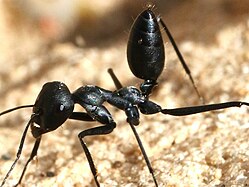
The gaster is the bulbous posterior portion of the metasoma found in hymenopterans of the suborder Apocrita (bees, wasps and ants). This begins with abdominal segment III on most ants, but some make a constricted postpetiole out of segment III, in which case the gaster begins with abdominal segment IV. [1] [2]
The gaster in ants contains what is sometimes called the "social stomach," which is named for the fact that food can be carried within it and then shared with other members of the colony. [3]
Certain ants in the genus Cataglyphis , including Cataglyphis bicolor and Cataglyphis fortis , have a cubiform petiole that allows them to decrease their inertia (and therefore increase their speed) by raising their gaster into an upright position. [4]
